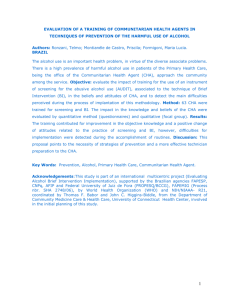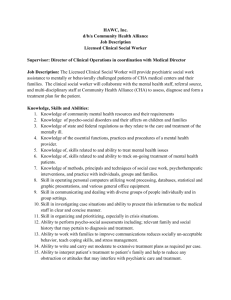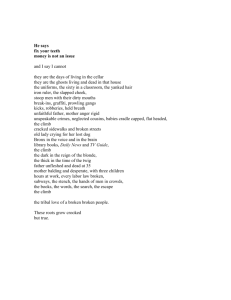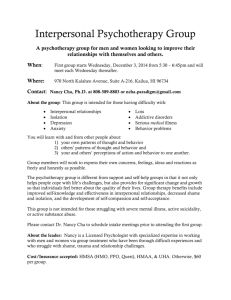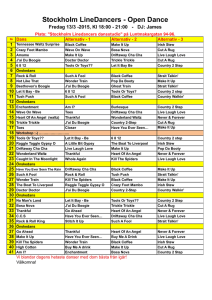2006 CHAM Orientation for Pharmacists
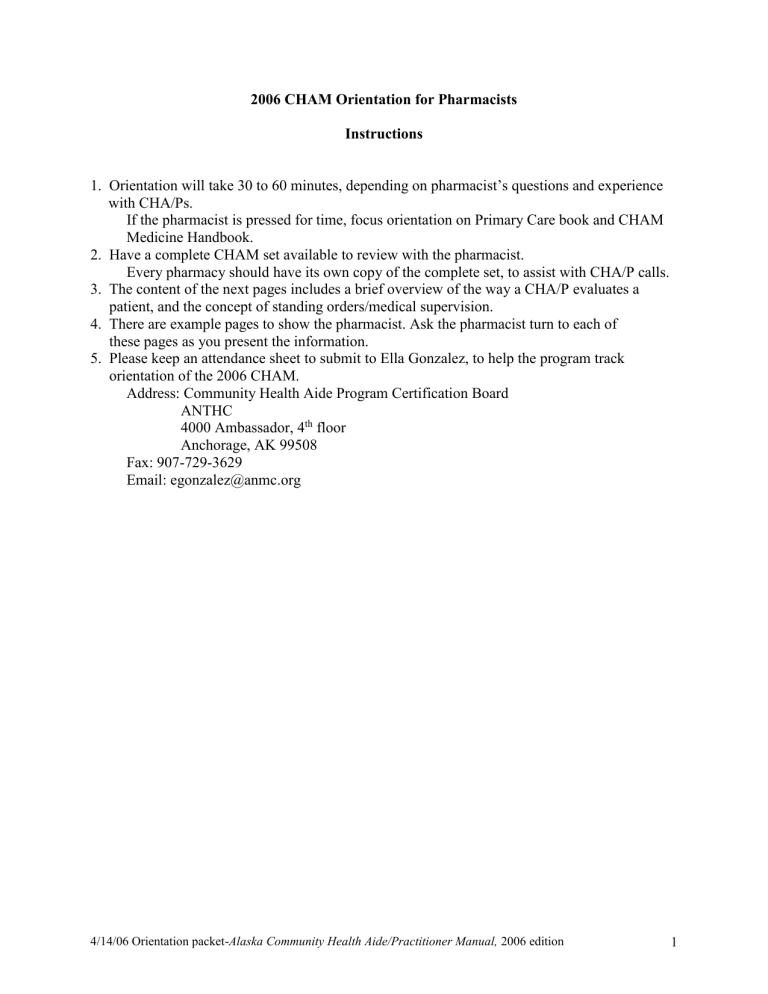
2006 CHAM Orientation for Pharmacists
Instructions
1. Orientation will take 30 to 60 minutes, depending on pharmacist’s questions and experience with CHA/Ps.
If the pharmacist is pressed for time, focus orientation on Primary Care book and CHAM
Medicine Handbook.
2. Have a complete CHAM set available to review with the pharmacist.
Every pharmacy should have its own copy of the complete set, to assist with CHA/P calls.
3. The content of the next pages includes a brief overview of the way a CHA/P evaluates a
patient, and the concept of standing orders/medical supervision.
4. There are example pages to show the pharmacist. Ask the pharmacist turn to each of
these pages as you present the information.
5. Please keep an attendance sheet to submit to Ella Gonzalez, to help the program track
orientation of the 2006 CHAM.
Address: Community Health Aide Program Certification Board
ANTHC
4000 Ambassador, 4 th
floor
Anchorage, AK 99508
Fax: 907-729-3629
Email: egonzalez@anmc.org
4/14/06 Orientation packetAlaska Community Health Aide/Practitioner Manual, 2006 edition 1
2006 CHAM Orientation for Pharmacists
The 2006 CHAM is a four volume set containing:
CHAM Emergency Field Handbook
CHAM Patient Care Book
CHAM Medicine Handbook: Combines CHAM Medicine Book and VMR
CHAM Reference and Procedure Book
CD-ROM containing an electronic PDF version of the four volume set.
CHAM Reference and Procedure Book
1. Major revisions in every chapter.
2. Briefly look at Table of Contents p. R-4 and 5
3. Only meds in this book are in End of Life Comfort Care chapter, p. R-312 to 316.
CHA/Ps are not responsible for village care of patient with terminal illness, but are often called by the family for help.
Emergency Field Handbook
1. New volume. For use by CHA who has completed Session I and ETT.
2. Designed to be used outside the village clinic. All plans send CHA/P to CHAM for
continued care in clinic.
3. Briefly flip through the book.
Look at meds on p. E-65, E-86 to 70, and E-74, 75.
Information about emergency meds is contained within this book.
CHAM Patient Care Book
1. This book contains patient visits for emergency, acute, chronic care, and preventive care.
2. Medicines used for emergencies:
Look at p. 57, Medicine; p. 58, Med charts.
Notice that there are NEVER standing orders for controlled medicines.
Look at p. 95, Chest Pain, Possible Heart Attack, Medicines.
Important information about these meds is included in the plan, so the CHA/P will not have to leave the emergency chapter.
3. [Ask pharmacist to follow along.] Using this book, the CHA/P takes a History, does a problem-specific or complete physical Exam, makes an Assessment, and follows a Plan for that assessment.
Example: Patient is a 6 year old with a sore throat and fever.
CHA/P starts history at Inside Front Cover, then goes to p. 290, Respiratory Illness for focused history and exam.
CHA/P then makes an Assessment using the appropriate assessment chart or list. Look at p. 292 to 295.
Our sample patient has history and exam findings, including a positive rapid Strep test, consistent with Strep throat.
4/14/06 Orientation packetAlaska Community Health Aide/Practitioner Manual, 2006 edition 2
If the CHA/P does NOT have a standing order for this assessment, she/he must report to the referral doctor before giving any medicine. Each plan specifies what the CHA/P can do while waiting to talk to the doctor. Look at p. 300, plan Respiratory 7.
Look at the report statement.
If the CHA/P has a current standing order, she/he may do the entire plan without reporting this patient, unless there is something in the Report NOW or ALWAYS Report section that must be reported, even with a standing order.
4. CHA/Ps are supervised by licensed physicians.
Initially a CHA must report every patient to the doctor (or designated PA or NP).
After training, village clinic practice, testing, and evaluation by field supervisors, a CHA/P may be granted Standing Orders to treat some problems without contacting the doctor. The
CHA/P is required to keep a list of his/her current signed standing orders. The CHAM recommends
Assessments with Plans that are appropriate for CHA/Ps to use by standing order.
A standing order may include giving medicines. In this case, the CHA/P uses the CHAM Medicine
Handbook to find information and dosing instructions for a specific medicine listed in the plan.
Medicine Handbook :
1. The CHAM medicine handbook contains only medicines listed in the CHAM.
Pharmacists are developing a statewide formulary for CHAP village clinics. All medicines in the
CHAM are included in that formulary.
Includes only meds that are stocked in clinic. No chronic care meds, such as HCTZ, Dilantin,
Lanoxin, etc.
Please help us encourage CHAP directors to place a commercial medicine reference book in each village clinic. The CHAM revision committee has recommended a nursing reference such as Lexi-
Comp, Mosby, etc.
2. Look at the medicines on p. 300.
Medicines are list in order of preference.
All treatment plans were reviewed extensively by Tribal Health Corporation doctors, medical specialists at ANTHC, and pharmacists.
The CHA/P selects a medicine, usually the first on the list unless there is a specific reason not to use that medicine in a particular patient.
CHA/P should select Amoxicillin suspension for this patient, since Pen VK tastes bad.
3. Now go to p. M-90, the CHAM Medicine Handbook.
All meds in this book follow a similar format.
Name, strength, and common brand names.
Brief description and uses.
Warnings box: Look at Amoxicillin warnings box.
Dosing for CHAM Plans.
Some meds have a dose chart, like this one.
Other meds list a specific dose. Look at p. M-119.
This medicine is used mostly for adult problems. If there is an indication to use in a child, those situations are almost always reported to the doctor because of child’s age. There are not standing orders for these problems.
Look at p. 298, Sinus Infection, and p. M-119, right column.
Serious and minor side effects.
Storage and preparation.
Patient Education.
4/14/06 Orientation packetAlaska Community Health Aide/Practitioner Manual, 2006 edition 3
4. Most medicines have a written Patient Education sheet that the CHA/P may print or Xerox.
Look at p. M-92, Amoxicillin.
These are pretty complete, written to a 6 th grade reading level. The patient ed was designed to encourage the patient to use the medicine, rather than scaring them with side effects. There is a note at the bottom of each sheet, instructing the patient to call your regional pharmacist for more information. It is not anticipated that this will occur very often.
5. If your corporation is using Telepharmacy, your pharmacy department may want to keep a list of current standing orders for CHA/Ps in your region. Otherwise you probably will not know whether
CHA/P is using a standing order or contacting the doctor.
Contact Heidi Brainard at ANMC pharmacy for information about this program.
6. Chronic care patients. Look at Right Inside Back Cover for a list of chronic care visits in this manual.
Look at p. 428, Arthritis Chronic Care visit.
Instructions about medicines are generic. CHA/P’s main role is to gather information about the medicines and request a med refill from the pharmacist, unless patient is having a problem.
If your corporation uses standard med refill sheets, the CHA/P is instructed to complete those.
Frequency of these visits often will depend on whether patient gets a one month or three month supply of medicine.
Information is on p. M-13 with samples on p. M-44-45.
7. Overview of CHAM Medicine Handbook
Inside Front Cover with instructions about how to give medicine to take home.
How to Use: description of this handbook.
Medicine Skills
Expanded Controlled Medicines section p. M-14.
Medicine Errors p.M-16.
Chronic Medicine Request Form samples M-45.
Immunizations: new refrigerator logs.
These pages will need to be updated as immunizations change. Will be done through
Immunization Program at ANTHC and Torie Heart’s office.
Medicines in the CHAM. There are many new medicines.
There have been significant changes in layout, dose, or administration of some meds, including:
Dextrose 50% M-71 : new routes of administration.
Epinephrine M-73 : IM for severe allergic reaction.
Naloxone M-82 : 2 strengths
Cefpodoxime M-103 : Note differences in plans
Ceftriaxone M-106 : 3 dosing schedules
Meds for status seizures: M-229 to M-232 .
These were decided upon by health corporation pharmacists, ANMC neurologist, pediatric neurologist, ANMC inpatient pediatric physicians, emergency physicians, and bush doctor.
Acetaminophen M-243 .
Ibuprofen M-259 .
Index: only includes items in this volume.
4/14/06 Orientation packetAlaska Community Health Aide/Practitioner Manual, 2006 edition 4
